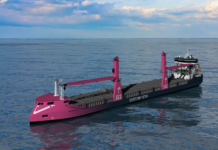
APM Terminals has introduced application programming interface (API) accessibility to build stronger, digital supply chains for logistics customers. APIs allow data to be transmitted in just seconds from the terminals’ operating systems directly to customers own transport management or logistics systems.
“We have co-developed our APIs with customers looking for real-time data to give them better visibility at the container terminal level,” said David Francis, APM Terminals Head of Digital Customer Solutions. Once a customer queries a container or multiple containers, they’ll receive the latest status of the container instantly. “By creating better integration with our data through APIs we can improve decision-making for our customers and remove supply chain inefficiencies, which are costing the industry billions each year. Never before, has speed and visibility been so key for improving the flow of goods and managing expectations.”
Currently, logistics companies spend a lot of time calling or emailing for cargo status updates. Over the last few months, this has been exacerbated by critical cargo for medical support and delays caused by reduced staffing. Apart from being inefficient in terms of human capital, this can also lead to error and delays.
Larger logistics companies may also rely on Electronic Data Interchange (EDI), which has been commonly used since the 1970s. However, as the internet’s capabilities have grown, the use of APIs are playing an increasingly important role, offering easier integration into digital ecosystems used by customers.
The packaging and sending of data using EDI can, in some scenarios, result in data being outdated several hours, increasing the likelihood of supply chain partners using incorrect information to make decisions. This makes APM Terminals’ APIs the a great solution for shipping lines, inland transporters, cargo owners and managers, and data aggregators who process higher volumes.
Initially, APM Terminals is making APIs available to track import availability at container level, including container data, estimated time of arrival and date of discharge from the vessel, the status of the container, any holds on the container, and whether a truck appointment has been made.
The company is also offering an API to track vessel schedules in real-time, including estimated arrival and departure times, and cut-off times for delivering a variety of container types.
The first locations to support the import availability and vessel schedule APIs are APM Terminals Pier 400 Los Angeles, California – North America’s largest privately-operated container terminal and Pacific gateway to the United States along with APM Terminals Port Elizabeth – the company’s largest container terminal on the US East Coast serving as the Atlantic gateway to the US and Canada – and APM Terminals Mobile, Alabama – the company’s US Gulf gateway to the Southeast, Midwest and Central Canada. Fifteen more terminals in the company’s global portfolio will be added by the end of the year.
อัพเดตข่าวสารและบทความที่น่าสนใจในอุตสาหกรรมโลจิสติกส์ก่อนใคร ผ่าน Line Official Account @Logistics Mananger เพียงเพิ่มเราเป็นเพื่อน @Logistics Manager หรือคลิกที่นี่














